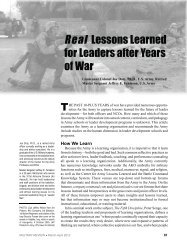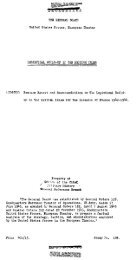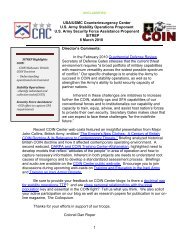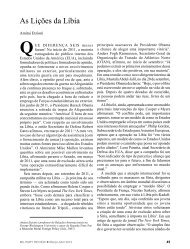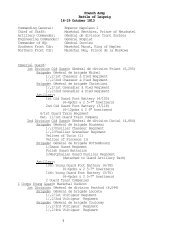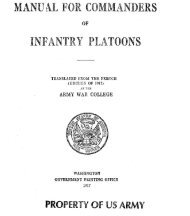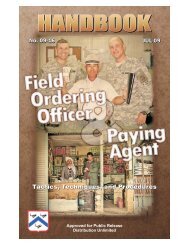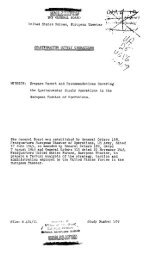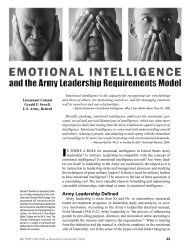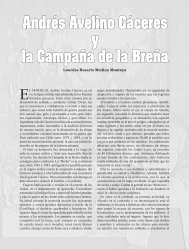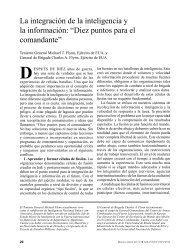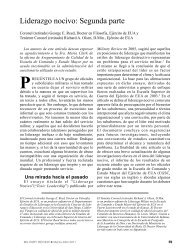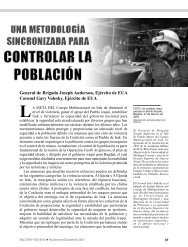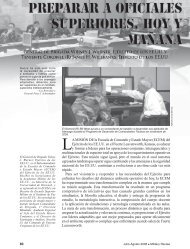Armor Magazine Counterinsurgency Selected Works - US Army
Armor Magazine Counterinsurgency Selected Works - US Army
Armor Magazine Counterinsurgency Selected Works - US Army
You also want an ePaper? Increase the reach of your titles
YUMPU automatically turns print PDFs into web optimized ePapers that Google loves.
endeavor failed, his position in the community would be reduced<br />
and his job imperiled.<br />
After some intense negotiations between security forces, the<br />
city mayor, and the sheiks, an agreement was reached. The persuasive<br />
arguments by the police chief and mayor won the day.<br />
Only males would return to a limited portion of the neighborhood<br />
in the beginning to “test the waters.” The IA, IP, and U.S. forces<br />
would provide route security to the neighborhood (a concern for<br />
residents), and the residents were allowed to keep AK-47s in their<br />
homes to protect themselves. If the neighborhood was as secure<br />
as they were told, they would return more people and families.<br />
Our first attempt at moving in individuals on 18 April was a<br />
failure. The males that returned brandished their weapons in the<br />
streets and caused some trouble with local residents. A severe<br />
sandstorm and IED reduced the number of forces we were able<br />
to provide. The sheiks, angered by a perceived lack of support<br />
and under pressure about the weapons incidents, withdrew from<br />
the area.<br />
Negotiations over returning the residents soon began again and<br />
after some delays and mediation, a more detailed and specific<br />
agreement was reached. Heavy security would be provided by<br />
U.S. and ISF forces units for the first 48 hours, and in return, the<br />
returning residents agreed not to brandish weapons or cause any<br />
trouble with existing residents. The chief of police proved critical<br />
to reassuring the Iraqis about providing enough security<br />
from ISF.<br />
On 27 April, approximately 50 males returned to the southwest<br />
portion of the neighborhood under heavy U.S. and ISF security,<br />
including aviation. Eager to avoid a repeat of the attempt<br />
nearly 10 days earlier, I collocated with the main Shia Sheik at<br />
the site to immediately resolve any problems. Fortunately, the<br />
entire move took place without incident. During the initial 2<br />
weeks, we maintained constant vigilance in the neighborhood,<br />
especially cautious about sectarian violence or retribution between<br />
the returned residents.<br />
Continuing Stability<br />
Maintaining our success was as big a challenge as achieving it.<br />
Securing the neighborhood required daily attention from the unit.<br />
In mid-June, we felt security conditions were permissive enough<br />
to conduct a town hall meeting, with leaders from the neighborhood,<br />
to elect a muktar (mayor) and address any grievances<br />
that local leaders may have. We conducted our first meeting on<br />
20 June with great success.<br />
Fortunately, none of our fears came to pass. AIF activity remained<br />
minimal to nonexistent in the neighborhood. As word<br />
spread, families arrived daily, with some returnees traveling over<br />
150 kilometers to reoccupy their homes. The ISF maintained a<br />
constant presence and manned checkpoints in the neighborhood.<br />
U.S. forces maintained almost daily joint patrols in the<br />
area, but refocused on developing the logistics and administrative<br />
skills of the IP and IA bases. The ongoing security of Sa’ad<br />
now rests almost entirely in Iraqi hands with U.S. forces providing<br />
“overwatch.”<br />
The operation had great second- and third-order effects in the<br />
Wahda and Rubiyah neighborhoods. Removing the insurgent<br />
base in Sa’ad denied insurgents easy entry into Wahda. In Rubiyah,<br />
residents petitioned for a police base similar to the one in<br />
Sa’ad. Our unit and the local police were happy to comply and<br />
the program was expanded in other company sectors.<br />
“To win in counterinsurgency, the local population must execute the<br />
long-term answer; our role is to set conditions that allow Iraqis to independently<br />
succeed. In Sa’ad, we set conditions for the return of ISF,<br />
who were fearful of operating in a dangerous neighborhood, which, in<br />
turn, set conditions for the return of displaced residents. The continued<br />
peace in the neighborhood is a testament to what ISF can do when U.S.<br />
forces serve in a committed support role.”



